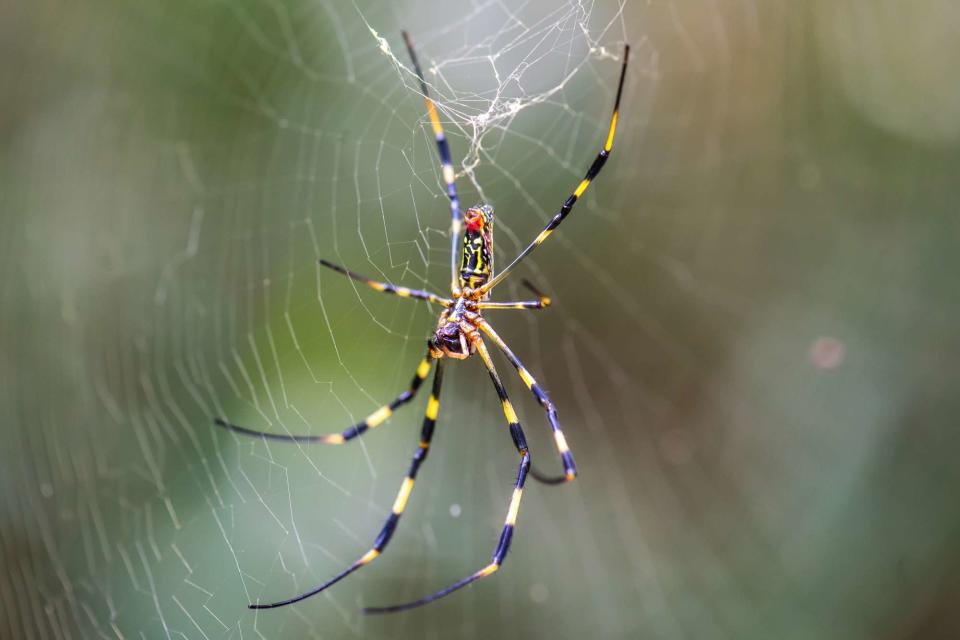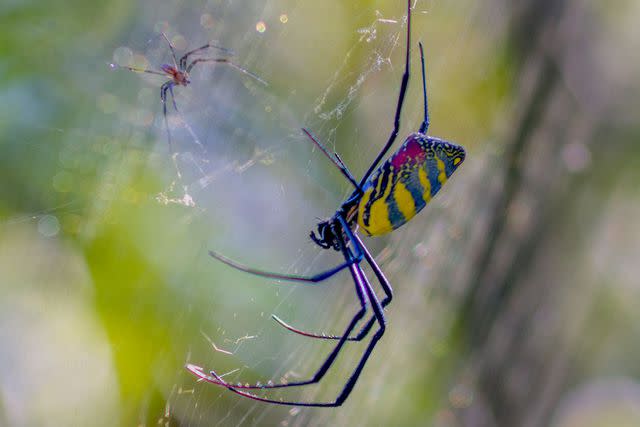All About the Venomous Flying Spiders Invading This Summer — and When They're Coming to Your Area
Here's what to know about the Joro spiders arriving this summer, including the states they're expected to invade

Getty
Joro spiderIt's a bird! It's a plane! No, it's a parachuting venomous flying spider!
Called Joro spiders, these enormous arachnids have been spreading across North America since the 2010s and are expected to continue making their way up the East Coast this summer.
Georgia was the first state to experience the invasion of the Joro spiders, believed to have made their way from East Asia via shipping trucks or containers around 2013. They are native to China, Japan, Korea and Taiwan.
Whether you have arachnophobia or not, many East Coasters are bracing themselves for the Joro spiders' arrival due to their size and poisonous nature (oh, and their ability to "fly"). The invasive species can have up to a 4-inch leg span and possess venom in their fangs.
But before your spider senses start tingling, these arachnids — scientifically titled, Trichonephila clavata (T. clavata) — are completely harmless despite their jarring characteristics. According to EarthSky, Joro spiders do not pose a threat to humans or pets and "may even be beneficial."
Plus, they don't technically "fly" in the avian sense. "Joro spiders utilize a technique known as ballooning, where they release silk threads into the air, allowing them to be carried by the wind," the New Jersey Pest Control shared.
National Geographic editor Christine Dell’Amore, who's led recent reporting on the Joro spider topic, tells PEOPLE exclusively that we "don't have to worry about them." She assures, "They're not going to sting you. They're not going to bite you."
Read on for what to know about the Joro spider's arrival, including when and where they're expected to invade the United States.
Related: Venomous Flying Spiders May Soon Invade the East Coast, Experts Say
What do Joro spiders look like?

getty
A large, female Joro spider on her web.Joro spiders, scientifically called Trichonephila clavata, are described as invasive arachnids native to East Asia. Depending on the spider's gender, their characteristics differ. In contrast to male spiders' smaller size, adult females can grow to the size of one's hand.
Mature females are also vibrant in color in comparison to the males' relatively colorless brown, according to National Geographic. The females have striped legs and abdomens that look like "they've been dipped in a pool of swirling yellow, red, and black paint."
Joro spiders themselves are an exotic sight to see, but their three-dimensional webs are even more spectacular. Adult female spiders can spin strong webs that are yellow-gold in appearance and can span up to 10 feet, according to a study by University of Georgia's Department of Entomology.
When are the Joro spiders expected to arrive in the United States?
Joro spiders spend winter in their egg sacs, emerge in the warmer weather and grow in the months that follow making them easy to spot due to their striking size. Therefore, spotting them depends on where you reside because they haven't yet made their way up the entire East Coast.
In fact, most of the Joro spiders have already "arrived" — but due to their small size when they hatch from their eggs, they aren't as easy to spot compared to their matured appearance.
Related: Get Ready for Sharkfest 2024! The Summer TV Event Promises a Month of Shark Excitement
Which states will be affected by the Joro spiders?

Getty
A joro spider waits in its web for preyIn addition to Georgia, which was the first state graced by their presence around 2014, Joro spiders are expected to work their way up the East Coast with the use of their ballooning technique.
"Spiderlings of this particular group are really good dispersers because of the way they're able to spin a piece of silk. It kind of acts like a parachute, if you will, and gets dragged by the prevailing wind currents," study leader E. Richard Hoebeke, curator of arthropods at the Georgia Museum of Natural History, told National Geographic.
Data from a peer-reviewed study published in November 2023 showed that "there is an abundance of suitable habitat for T. clavata throughout eastern North America and in some areas in the western part of the continent."
"Those data show that this spider is going to be able to inhabit most of the eastern U.S. It shows that their comfort area in their native range matches up very well with much of North America," David Coyle, one of its authors, shared in a press release.
As of October 2022, the Joro spider's range spanned across Georgia, South Carolina, North Carolina and Tennessee. There were also reports of the species in Alabama, Maryland, Oklahoma and West Virginia.
Related: Invasive Fish Species with Snake Head Found Once Again in Missouri
José R. Ramírez-Garofalo, an ecologist at Rutgers University's Lockwood Lab, told the Staten Island Advance in April 2024 that "it is a matter of when, not if," the spiders make their way to New York and New Jersey.
However, National Geographic's Dell’Amore tells PEOPLE that it's unlikely Joro spiders would make it up to New Jersey and New York from those states by this summer "that quickly."
She explains it can take "several generations for a spider to spread" despite the ballooning behavior the young spiderlings use to travel to different places. "It would take multiple years for them to reach the US Northeast."
The Royal Entomological Society's February 2022 study proved via lab experiment that Joro spiders "can exist in a colder climatic region," but Dell’Amore points out that "there isn't proof in real life yet that they can survive New England winters." She adds, "There's no evidence that they have made it to these states and established populations yet."
Are the Joro spiders dangerous to humans or pets?
Since Joro spiders are capable of living in "human-dominated landscapes," per a study published by the University of Georgia in February 2024, it makes sense why fear and anxiety are prevalent among many ahead of their arrival.
However, Joro spiders pose zero threat to humans or pets. Yes, they have venom in their fangs... like all spiders do!
David Nelson, a professor of biology at Southern Adventist University who has studied the growing range of Joro spiders, told NPR that a bite from one of these creatures might itch at worst or perhaps cause an allergic reaction.
According to a February 2023 University of Georgia study, Joro spiders have an "extremely shy and non-aggressive personality" as a result of an air puff test that caused them to remain "in a frozen state" for over an hour!
EarthSky notes that Joro spiders "may even be beneficial" to us. The site explains, "The spiders eat insects such as stink bugs, which cause crop damage and swarm in homes. They can help control insects without the use of pesticides."
Should Joro spiders be killed?

Getty
A Joro spider is seen making her web nests.Whether you're arachnophobic or not, Dell’Amore tells PEOPLE "there's no need to kill spiders when you see them." That goes for Joro spiders, too.
"There are only very few spiders that are actually harmful to people and those are black widows and brown break loose spiders," she points out. "The vast majority of spiders are eating pests and playing important roles in the ecosystem."
In fact, Dell’Amore says spiders "don't want to interact with us." Therefore, she stresses "we should be good neighbors to them, let them do their thing and we do our own thing." She adds, "We can coexist peacefully."
For more People news, make sure to sign up for our newsletter!
Read the original article on People.

 Yahoo News
Yahoo News 
